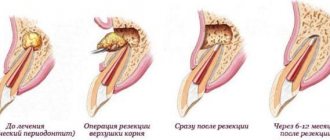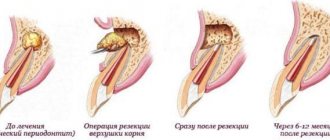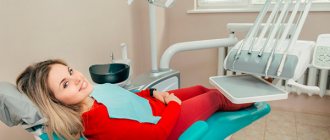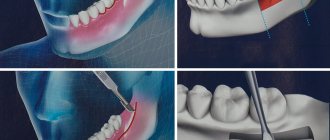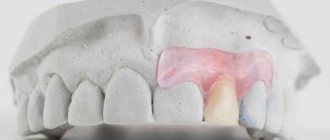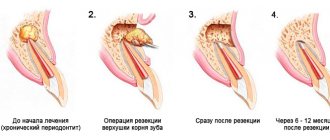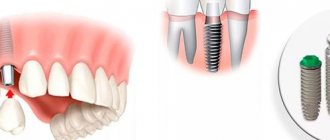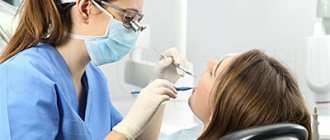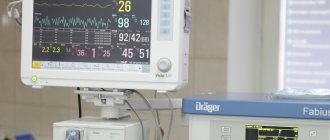Patients with chronic periodontitis often encounter a situation where a cyst forms at the apex of the root - a cavity in the bone tissue filled with pus. Most often, a cyst develops due to infection in the root canals; sometimes the cause of a cyst is trauma, inflammatory processes in the periodontium (gums) and adjacent areas. It can also occur due to undetected caries, pulpitis or periodontitis, as well as due to poorly filled root canals.
Such a neoplasm may not bother a person for a long time. As a rule, a cyst makes itself felt during periods of weakened immunity, against the background of a cold. In such cases, the infectious process in the cyst cavity worsens, which leads to abundant pus formation. The patient feels acute pain, swelling and swelling of the gums appears, and a fever may appear. The main thing is to seek dental care on time. In these cases, resection of the apex of the tooth root and dental surgery to remove the cyst are used. However, you can often get by with therapeutic treatment.
When deletion is indicated
Modern dentistry strives to preserve teeth and their roots whenever possible, but this is not always possible. Dental surgeons remove teeth with cysts for the following indications:
- the infectious process was caused by an advanced form of periodontal disease;
- there is a vertically located crack on the root of the tooth or on itself;
- the dental root canals are impassable, as a result of which therapeutic treatment becomes impossible;
- severe tooth decay, and restoring it does not make sense (too expensive and time-consuming);
- the tooth is located entirely in the cavity of the neoplasm;
- the cyst has grown into the nasal cavity, or the size of the tumor is more than 10 mm;
- the root of the tooth has fused with the neoplasm;
- the tooth is very loose.
The dentist decides to remove a tooth with a cyst after a thorough examination of the patient, which includes examination, history taking, radiography or visiography.
Why don't we remove the cyst with a laser?
After analyzing all the long-term results of the postoperative period from our department and partner organizations in Moscow, it was decided to abandon the further use of laser cyst removal.
When all the results were analyzed, it turned out that the positive disinfecting effect of the laser was seriously compromised by the longer recovery process. It has been determined that when removing a cyst with a laser, high-temperature exposure, forming burn areas, provokes inhibition of tissue restoration and prolongation of treatment time with a weak antiseptic advantage.
The marketing benefits of “laser treatment” for business were not taken into account in this study. Thus, laser removal of cysts is no longer performed in our Center.
Removing a tooth with a cyst: does it hurt or not?
In the “Optimal Choice” dental clinics, when removing teeth with benign formations at the roots, the latest anesthetics and modern equipment are used. Therefore, patients do not need to be afraid of anything at all. The doctor selects anesthetics on an individual basis; in some cases, general anesthesia may be recommended (we do not use it). Minor pain may occur after tooth extraction, when the anesthesia wears off. To relieve pain, your doctor may prescribe painkillers.
What does the cost consist of?
Removal of a dental cyst includes two stages - endodontic preparation of canals and surgery to remove the cyst, which are calculated separately
Endodontic canal treatment
If you try to plan the preparatory therapeutic stage of treatment, then it is impossible to calculate everything down to the penny before opening the tooth and examining it under a microscope. At the initial consultation, a microscopist is present, who draws up his estimate for the preparation of root canals.
The cost of root canal treatment depends on their number, and is calculated for each one.
Standard price includes:
- mechanical and medicinal treatment of canals
- temporary filling with medicinal pastes
- 3D canal filling
By default the price includes:
- local anesthesia
- use of a microscope in treatment
- use of rubber dam and optagrate
If additional measures are necessary, the following will be added to the cost:
- unsealing of canals filled with resorcinol-formalin method or cement
- removing a pin or foreign body from the canal
Cyst removal
In the surgical department, everything is simple - there is a fixed cost for the operation.
The package price for dental cyst removal includes:
- local anesthesia
- all necessary surgical procedures
The price depends on the complexity of the intervention
, which is determined by anatomical features that lead to complications of treatment:
- the cyst affects the roots of several teeth
- germination of a cyst into the neurovascular bundle of the lower jaw
- the cyst is in contact with the maxillary sinus
In such cases, we ask you to understand that the operation time is extended and the cost of treatment increases. In some cases, the cost of the complexity factor leads to a 50 percent increase in price.
Additional activities are paid separately, but are not always required:
- Rehabilitation of lost bone volume - the cost of bone grafting of a defect depends on the size of the cavity formed by the cyst and the volume of the drug injected. Bone materials are written off at the purchase price in a separate act. The procedure is not mandatory; its necessity depends only on the rate of regeneration of your bone.
- Removal of the tooth itself - the price depends on the complexity of the operation. Removal of wisdom teeth and the use of pre-implantation preparation technology are always more expensive than simple cases.
Types of deletion
A dental cyst can be treated using one of the following surgical methods:
- Cystectomy is the most common way to remove cysts on teeth. During this operation, an incision is made on the gum, through which both the benign neoplasm and the apex of the tooth root with pathology are removed. The cystectomy procedure is usually performed under local anesthesia, after which the doctor prescribes antibiotics to the patient.
- Hemisection - this type of removal is used if a tooth with a cyst has more than one root, and at least one of them is pathologically changed. During this procedure, the cystic formation, the root of the tooth with pathology, and part of the tooth itself are removed. After this operation, a crown is placed on the tooth.
- Cystotomy is the most gentle type of surgical treatment for dental cysts, in which the doctor removes only the front wall of the tumor. The tooth body is completely preserved.
These techniques are an alternative to the complete removal of teeth with cysts. But it is not always possible to apply them. To completely remove teeth with benign tumors, the extraction method is used. The operation can be performed urgently or planned.
Alternative Methods
A neoplasm localized at the root apex can be treated conservatively if its diameter does not exceed 8 mm and the root canals are not sealed. In this case, access to the affected area is through the crown.
Therapeutic treatment
The root canal is depulped, cleaned, and expanded. The cavity is cleared of purulent masses, treated with antiseptics, and filled with a special paste. After treatment, the canal and crown part of the tooth are filled. You need to be examined within a month to rule out relapses.
Laser treatment
It is carried out similarly to the previous method, only the capsule is exposed to a laser. Laser beams quickly remove the tumor and disinfect the cavity. After such a procedure, the recovery period is easier and faster, and complications are minimal.
What are the stages of the operation?
The procedure consists of the following steps:
- The desired area is numbed using conduction or infiltration anesthesia.
- The gum is peeled off from the wall using a rasp.
- The tooth is loosened and removed using forceps or an elevator.
- The dental unit is removed from the socket. In difficult cases, the tooth is first sawed into pieces using a drill, and then each of them is removed separately.
- The extracted tooth and socket are examined by a doctor.
- The cyst cavity is cleaned, and the wound is treated with antiseptic drugs.
- The wound is stitched up.
- Using an X-ray examination, the doctor makes sure that fragments, particles of the tooth and the removed tumor do not remain in the jaw.
- Antibiotics, anti-inflammatory drugs and anesthetics are prescribed.
Two to three days after the operation, you need to re-visit your dentist to monitor the condition of the tooth socket.
Rehabilitation period
After the procedure, swelling and pain occur, the temperature may rise, and the head may hurt. Acute symptoms are relieved with analgesics and anti-inflammatory drugs. Antibiotics are prescribed to prevent infection. They are also needed to prevent relapse and the formation of a new capsule under the extracted tooth.
Doctors recommend:
- eat liquid, soft food at a comfortable temperature;
- do not lick the blood clot;
- avoid high physical activity, temporarily stop playing sports;
- do not overheat the body (hot bath, sauna, bathhouse, beach, etc.);
- stop smoking and alcohol, as this has a bad effect on wound healing;
- rinse your mouth after eating;
- Use a soft-bristle toothbrush, avoiding the operated area.
It is useful to rinse your mouth with soda or salt solution, decoctions of chamomile, calendula, and oak bark. You can use pharmaceutical antiseptics: Chlorhexidine, Miramistin, Romazulan.
Possible complications
Among the common consequences of removing a tooth with a cyst may be the following complications:
- slight increase in body temperature;
- migraine;
- soft tissue swelling;
- toothache.
In order to alleviate the patient's condition, symptomatic treatment is prescribed.
If the doctor is insufficiently qualified or the patient does not comply with medical recommendations, the following complications may arise as a result of surgical intervention:
- infectious process in tissues;
- injury to nerve endings;
- profuse bleeding.
To avoid this, you must contact only trusted dentists with good experience and clinics with modern equipment, and also follow all recommendations given by your doctor.
Is it possible to eliminate pathology at home?
Since the infection affects the dental root, it is impossible to cure yourself without a visit to the doctor. Traditional methods should be used as adjuvant therapy. To reduce the inflammatory process, it is recommended to rinse the oral cavity at home. The simplest rinsing solution can be prepared from water and a mixture of salt and soda. Herbal decoctions with antiseptic and anesthetic properties have proven themselves to be effective. To prepare the solution, you can use sage leaves, chamomile, horsetail, and alcohol tincture of calendula.
After brewing the plant material, the composition should be stored in the refrigerator. Before use, the mixture is slightly warmed. It should not be cold or too hot.
Preventive measures
To ensure tissue healing proceeds faster and serious complications do not arise, a number of recommendations must be followed. Dentists at the Optimal Choice clinic give the following advice to their patients:
- For several days after surgery, rest is required; any physical activity (even light) is contraindicated;
- avoid hot water procedures, including baths, steam baths, saunas, and do not use hot compresses;
- You cannot use active mouth rinses for 2-3 days; if necessary, they can be replaced with oral baths with infusions or decoctions of medicinal herbs (with oak bark, calendula, eucalyptus, sage), furatsilin, chlorhexidine, etc.;
- do not drink alcoholic beverages or smoke for 2-3 days;
- Taking medications prescribed by a doctor is mandatory.
Compliance with these rules, as well as regular visits to the dentist for preventive examinations and at the slightest unpleasant symptoms, will allow you to avoid serious negative consequences and significant financial expenses for dental services.
How is the rehabilitation going?
After removal, the anesthesia ends, and the person feels pain in the injured areas of the jaw, and swelling is possible. But there is no reason to worry. As healing progresses, the discomfort will disappear.
After the cyst removal procedure, refrain from drinking and eating for several hours. You must rinse your mouth carefully. Recovery after surgery will take approximately 5 days. During this period, refrain from hot or very cold foods and do not drink alcohol. Smoking is also undesirable.
If antiseptic solutions are prescribed for rinsing the mouth, be sure to use them. If the initial pain is severe, you can use painkillers.
If pain, swelling, or fever persists for more than a week, immediately contact your dentist.
At the One to One clinic, dentists work in two of the most well-known methods today - cystectomy and cystotomy. The specific method is determined by the doctor based on examination of your teeth. For detailed information about treatment conditions, please call +7.
Experts' opinion
Question: Is it possible to avoid the occurrence of a cyst on a tooth?
Answer : The etiology of the formation of a cyst at the root of a tooth can be different. At the initial stages, treatment of this pathology does not pose a serious problem. Therefore, it is very important to be regularly examined by a dentist, and also to take x-rays or visiography at least once a year to identify any pathologies of the dental system. New growths, if present, will also be visible on the images. To reduce the likelihood of tumors appearing, if any diseases of the oral cavity and nasopharynx occur, it is necessary to treat them in a timely manner: develop the habit of regularly rinsing your mouth with antiseptics, and learn to brush your teeth correctly. Maintaining a healthy lifestyle, a balanced diet, a strong immune system and preventive dental examinations are the key to dental health.
Question: Is it possible to get rid of a cyst on a tooth at home on your own?
Answer : We do not recommend self-medication if you have any pain or unpleasant symptoms in the oral cavity. Any discomfort may be a sign of a serious illness that requires medical attention. If it is not possible to urgently visit the dentist, then to reduce pain you can use the following rinses: herbal decoctions (yarrow, calendula, sage, chamomile, oak bark), a solution of baking soda or salt, vodka, tea tree essential oil. This may help reduce pain, but in any case you should see a doctor as soon as possible.
Causes of the disease
A lesion occurs when an infection enters the dental canals. This can happen for various reasons:
- Caries, other diseases of the oral cavity;
- Violation of technology when installing a pin, filling canals, endodontic procedures;
- Complications of sinusitis and other infectious diseases.
Very often, suppuration occurs as a result of a jaw injury. People who practice various types of martial arts and participate in street fights are at risk. You can injure the dental system at home by cracking nuts.
